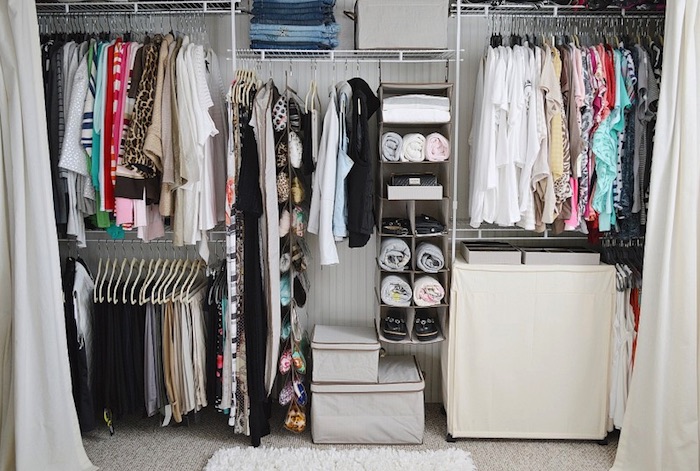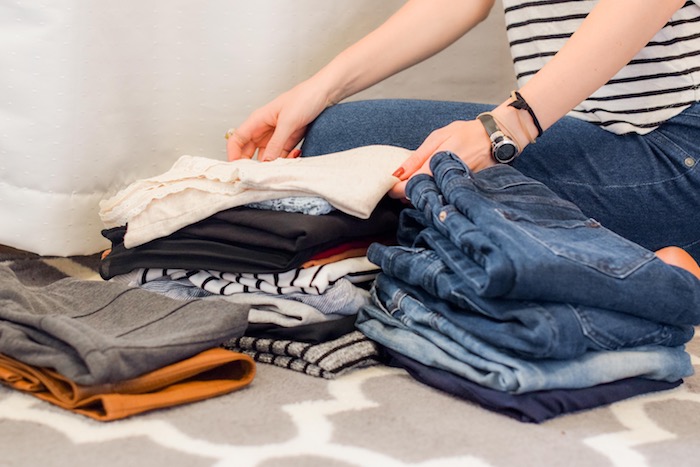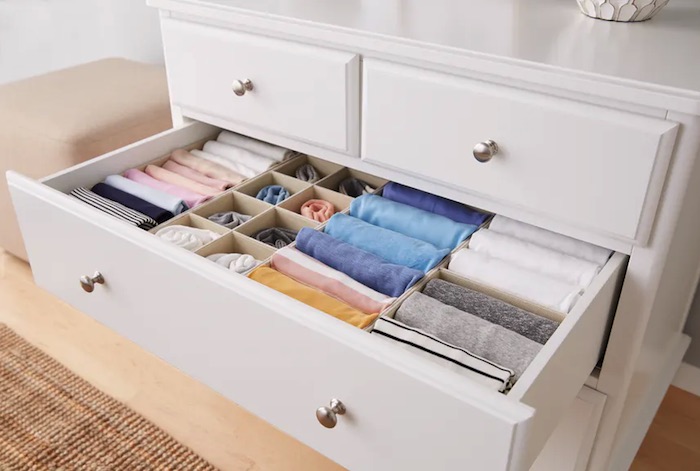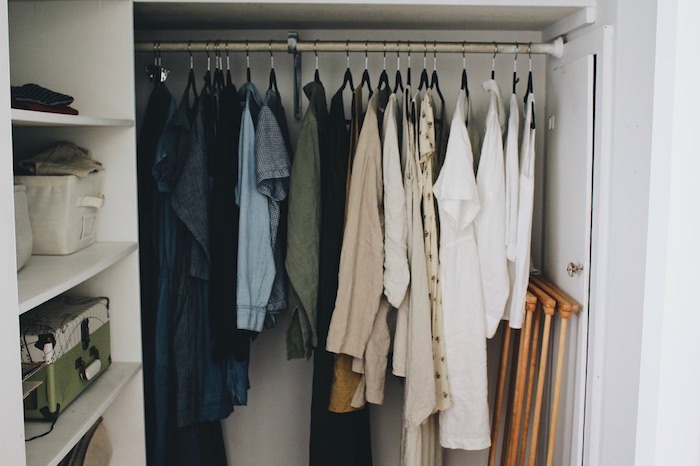
Some of us have an intense love for shoes and others own a different sweater for every day of the week… while these examples have different needs, these closet organization tips can help you create a clutter-free closet space you’ll love getting dressed in.
Many people have leaned way into the Marie Kondo age of owning less but if you find pride in your shoe or sweater game, then you do you. We’re just here to give you a step by step guide to organizing everything in your closet.
How to Organize Clothes in Your Closet:
**Click to auto scroll by section
- Envision an Effective Layout
- Do a Deep Cleanout, Downsize & Declutter
- How to Sort Clothes By Category
- Design Your Ideal Closet Space
- How to Organize Your Closet by Color
- Organize Closet by Height or Bulkiness
- What Clothes Go on Shelves or Drawers
- What Order to Hang Clothes in Closet
- How to Organize Accessories
Step 1. Envision an Effective Layout
You can’t cure the symptoms of a disorganized closet until you know what is causing them! Open your closet and pretend you’re getting dressed or picking out an outfit.
Make note of the things about your closet that slow you down to come up with the most efficient way to organize your closet for your needs.
Here are some questions to help you started:
- What is there clearly not enough space for?
- Is it making you bend down/reach up too much?
- How long does it take to pick out an outfit? Why?
- Is there miscellanea junk that needs to be tossed?
- What can’t you see? Is it too dark? Is it too crowded?
This list of problems will come in handy when it’s time to design your ideal closet so we can make sure every closet organizer is used with the intention to fix a specific problem, instead of ending up with a bunch of random furniture that only halfway fix half of your problems.
Step 2. Do a Deep Cleanout, Downsize & Declutter
If you followed our guide for how to declutter and completely clean out your closet, then you’re good to move on to step 3. If you haven’t, do not skip decluttering your closet!
Bonus: Space between hangers makes it easier to find clothes while maintaining them wrinkle-free.
If you need help determining what you should keep and what you should toss, following this closet cleanout flowchart can help.
Download: How to Clean Out Your Closet Flowchart here.
Simply go through your closet and sort piles of keep, consign, donate, upcycle or trash.
Keep clothes that still fit, are comfortable to wear, and have been used in the past year. Gently used clothing can be dropped off at donation or thrift stores, and your more pricey pieces might make you extra cash at local consignment stores.
If you’d prefer to avoid people or there aren’t any available donation centers, standalone donation boxes can often be found in large parking lots so you can slide unwanted clothing and accessories in there.
If you’re doing a deep closet redesign, a quick, hassle-free way to get rid of extra closet junk is by booking a junk removal service like LoadUp to pick up your old clothes, broken shelving, old dressers and more.
Step 3. How to Sort Clothes By Category

Sorting your clothes makes it clearly apparent how much you have of each category and therefore get a solid estimate of how much space they’ll need. Then, once you have them all accounted for, you can designate the proper place for them like a professional.
Categories to organize your clothes into zones:
- Tops: Layer them by sleeve length – tank tops, t-shirt, short sleeves, long sleeve.
- Bottoms: Sort by type: jeans – jean shorts, skirts, pants, shorts.
- Shoes: Line them up by type – sneakers, heels, flats, boots, house shoes, dress shoes.
- Other: Group accessories, gym clothes, dresses, formal wear, coats, and undergarments.
Step 4. Design Your Ideal Closet Space
Use your list of everything that’s wrong with your closet to create solutions to every problem you noticed. Instead of spending a ton of money on an expensive closet system, measure the space you have and get creative with it. You can plan to add shelving and drawers, but leave enough space for longer items like dresses.
Re-purpose what you already own like bookshelves or plastic cabinets of drawers to build a great organized closet on a budget. If you don’t have anything on hand to help you organize your closet, don’t fret. Your end result is going to be way better than what you started with, but keep a creative eye out for things like hanging racks for necklaces or boxes for dividers.
The closet “blueprint” doesn’t have to be detailed and can be equivalent of stick figures. Just basically outline where the prime real estate area in your closet is, put your go-to’s there, and leave the worst real estate for clothes that are only worn a few times a year.
Step 5. Organize Your Closet Top to Bottom
Okay, now for the part you wanted to do from the very beginning, it’s time to organize the freakin’ closet. Gather your materials before starting the organizing process to avoid wasting time running around the house looking for a hammer or more push pins.
Shorties, a collapsible step stool will make this whole thing easier and reduce fatigue so bring one and leave it in there for daily use. Even you taller folk might want one! We’re not going to pretend that, as time goes on, things aren’t going to fall to the back of the shelves so a stool helps you clearly see everything in your closet.
How to Organize Your Closet by Color
To organize your clothes by color, decide on a pattern that pleases your eye the most. If you have a ton of neutrals, lightest to darkest is easy. If you have more color, you can try black to gray, then white to off-white, beige to brown, blue to purple, pink to red, and green to yellow.
Organize Closet by Height or Bulkiness
Or you can organize your clothes by silhouette. Which is kind of a fancy way to say you choose to organize either by material, style, or purpose. For example, all tops would go together and then could be sectioned by purpose like date tops, work tops, pajama tops or by type such as button-downs, t-shirts, turtle necks, etc.
Whatever pattern you decide, stick to it for every step of the organization process to keep your wardrobe from looking like a tie-dye explosion and so it’s easy for you to create outfits.
What Clothes Go on Shelves or Drawers
The most basic closets at least have one shelf at the top, with a rod under it, then a ton of empty space below for your clothes to dangle and experience gravity. This closet situation is fine if all your stuff hangs well, but typically not all of it should.
For ideas on how to organize each item, keep reading but here’s a list of clothes that can go on shelves or drawers:
- Shoes
- Sweaters
- Socks and Underwear
- Gym Clothes
- Tank Tops and T-Shirts
- Jeans, pants and leggings
Sweaters
The cardinal rule of keeping a nice sweater looking like new is to never hang it. Folding is the way to go because gravity can’t stretch it and affect its shape. Worst case scenario, if you absolutely have to hang it, thick padded hangers can help avoid warping the shoulders.
If you just have a handful of sweaters, try folding them sideways like files into your dresser so you can see them all without digging. However, if you live in sweaters, then a cubed shelf or clear storage drawers can hold them in stacks of three to five. The cube shape keeps them from toppling over making your closet look like a hot mess.
Jeans, Pants and Leggings
It’s easy to be unsure how to organize pants in your closet, but it’s truly based on your personal preference plus the space that you’re working with.
Jeans can be hung or folded, but if you’re organizing a small closet with limited hanging room, folding and filing them into a drawer is the way to go. Remember to organize your jeans either by color or style such as bootcut, skinny, flare, etc.
If you own corduroy or other textured pants, don’t hang them unless you can clip them at the waist to avoid ruining them with a permanent hanger line.

Tank Tops, T-Shirts, and Gym Clothes
Don’t stack anything on top of each other and place them in a drawer. Fold tops normally, then fold them in half again and line them up in the drawer one behind the other (like a filing cabinet) so you can see each the rim of each top. Bottoms like leggings, yoga pants, running pants, or shorts should also be similarly folded and stored close to your tanks and t-shirts.
💡Pro Tip: Cut off the lids to empty shoe boxes and use them inside drawers to create divisions.
Socks and Underwear
Easily one of the messiest drawers is the sock and underwear drawer. They’re small, hard to fold, and just so easy to ball up and throw in a drawer. Sorry, but the time for change has come.
Start by separating socks by color and underwear by style. Decide to shape up and start folding them neatly inside of drawers, or give up entirely on folding but purchase organizers that are separated into tiny sections with just enough room to hold one or two pieces.
This will not only keep everything in place, giving the illusion that you spent a few minutes gracefully setting them in there, but it’ll also help avoid wearing navy socks with black pants.
Shoes
Most likely you have limited shelf space, but are tired of bending down to determine what shoes to wear. Luckily, there are so many space-saving shoe organizers out there.
An over-the-door shoe rack makes your door the perfect place to store shoes, accessories, or both. They also sell cloth vertical organizing systems that house one pair of shoes per cubby that hang on clothing rods. These can not only hold your shoes but also work as a divider.
Or, if you’re like that shoe collector from the beginning of the article, you can keep them protected in clear plastic bins with pictures of the shoe on the front. This takes up a bit of space though, so this option is more for shoe connoisseurs or those with space.

What Order to Hang Clothes in Closet
You should now be left with hang-able, day-to-day items that you wear most often. Whether you’re organizing your closet by color or silhouette, try to save the front and middle of your closet for clothes you wear most often.
So, if you’re a bleary-eyed, sleep-drunkard in the morning, show yourself some mercy and hang your work clothes at the front of your closet. If this forces your color pattern to shift a little, then so be it.
These are types of clothes you should hang in your closet:
- Button Downs, Blouses and Nice Tops
- Suits, Coats, and Formal Wear
- Dresses and Skirts
Hangers, Blouses, and Tops
Any top that isn’t a tank, sweater, t-shirt, or workout-related should be hung on hangers that won’t damage them. Wire hangers are notorious for ruining nice shirts by either warping, tearing, or staining so do yourself a favor and recycle those suckers.
It depends on your closet if you need felt, clip, wood, or plastic hangers, but a good rule to follow is thin and the same color to avoid being blinded by a kaleidoscope of hangers.
Suits, Coats, and Formal Wear
Most of us don’t wear formal items often so they should be stored toward the back or in other “bad real estate” areas. Protect and organize suit jackets and matching pants with wide-shouldered suit hangers that come with a pant bar. They allow you to hang pairs together, but these hangers are also sturdy enough to maintain the shoulders in blazers and heavy coats.
When your coats are out of season, slide them to the back of your closet. For those that live in especially frigid areas, store poofy jackets a box elsewhere to reserve valuable space for things you need on the regular.
Dresses and Skirts
Split up dresses by casual and formal so the casuals are easy for you to grab and go, and put the formal ones with your other gear in the back. Then group them up by the organization system you decided on (color or type). Organize your skirts the same as your dresses, only they should be clipped by the waist and hung on skirt hangers.
For very long maxi dresses, you can use two hangers. Slide the bodice over one like normal, and sling the skirt through the second hanger on the bar where you’d sling pants over. It’s obviously ideal if they can hang long to avoid unnecessary wrinkles, but cluttered, bunched up textiles on the floor of your closet isn’t much better.
How to Organize Accessories
Don’t forget to organize your jewelry by metal type, color, and style! Necklaces can be hung on thumbtacks or hanging racks of any kind, but for everything else like rings, bracelets, and scarves, a drawer, box, or bin is best.
Accessories such as purses and scarves can be placed in clear boxes or aesthetically displayed in wicker baskets on lower shelves that you can see.
For ties and belts, hang them on a rack or hook. There are many of hanging organizers that can hold them all neatly and cascade them down so you can still see patterns and colors, but, if you can’t find any, you can also roll and place them in small bins within a drawer.
Get Rid of Clothes That’s Left and Maintain It
Right now you may have a lot of time to keep your organized closet spick and span, but, once life gets busy, keeping it up can get tricky. Make a schedule for yourself to toss out things you don’t wear at least once a season, and tackle a full closet overhaul at least once a year.
Always evaluate the condition of not just your clothing items, but also the dressers, cabinets, organizers, and more. When things start to fall apart and get worn down, bag them and toss them! Hoarding clothes in your closet only makes you feel like your whole closet sucks.
In other words, next time you can’t find what you need or your dresser drawer keeps jamming, that’s a good sign you need to re-org your closet and call LoadUp to haul away the rest.
Related Articles from the Trash Talk Blog:

